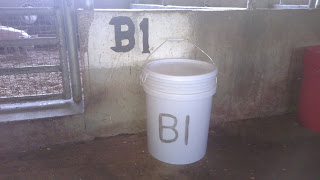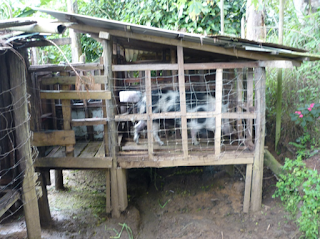8. The feeding trial: Kau kau silage v commercial pellets
In this blog the feeding
trial results are presented.
Two dietary treatments
were compared. The pigs were randomly allocated to two groups. The
control group was fed the standard commercial diets for weaner, grower and
finisher pigs used on the 400 sow Boroma commercial farm just down the
road. The test pigs were fed the fermented sweet potato (kau kau) tuber
silage combined with a protein mineral premix at 30% of the diet from 12 weeks
of age to 15 weeks and 25% from 16 weeks until 23 weeks.
We knew that the smaller
pigs would struggle with silage feed intakes necessary to achieve the amino
acid and energy intakes necessary to compete with the animals fed the
commercial diets. Since most feed is consumed by pigs more than 40 kg
liveweight we wanted to see how these performed. We were quite prepared
to feed a commercial diet until at least ten weeks of age. We could look
more closely at the performance of the younger pigs later. In any case we had
no choice because the repair of the kau kau mulcher delayed the start of the
experiment until the pigs were 12 weeks old.
 |
| Feed for each pen weighed and fed by bucket. B1 was a control group, fed by a white bucket. |
 |
| Trial pigs about 14 weeks old |
We provided Isidor with
a feeding scale that increased the amount of feed offered each week. Staff
weighed out the estimated amount of kau kau silage to be fed, mixed in the
protein mineral balancer at 30% or 25% by weight of the silage depending on the
age of the pigs and then distributed it to each pen according to a feeding
chart for each pen.
The kau kau, premixed
with the supplement, and the Boroma commercial diet were measured into the feed
trough twice each day. Food not consumed by the time of the next feed was
removed and weighed. We didn’t know exactly how much they would eat in the
tropical Port Moresby climate. We were guided by intakes of Australian pigs so
fed them according to a feeding scale based on energy intakes predicted by the
Auspig pig growth computer model but were prepared to offer them more.
Five faecal samples were
taken from each pen when the pigs were 20 weeks of age for faecal egg counts
all with negative results. Pigs falling behind were assessed, temperatures
taken, clinical signs recorded and treated if necessary. Dead pigs were
weighed and measured.
Staff took a keen
interest in the pigs and their performance. They were very impressed by how
quickly the pigs grew. Miriam wrote in her weekly reports,
“It is very surprising
to see how much these pigs have grown. From my observation, I have seen that
they have gained much weight and are very healthy. The second batch is catching
up with the first batch.” They weren’t really, but they were growing very
quickly by PNG standards. People were still talking about their
performance 6 years later.
Of the 90 pigs that
started the trial 84 finished. Six pigs died, one from the control
group and five from the treatment group. Two of the pigs from the
treatment group died while they were being fed the same pellet diet as the
controls, in the first few weeks of the trial. Three died while they were being
fed the silage diet, but these numbers are too small to mean anything
statistically.
 |
| Fig1. The pigs fed pellets grew faster than those fed silage. |
The pigs in both groups
grew well for pigs raised in a hot climate. They reached 90-95 kg in 170 days for an average daily gain of 529 and 560 grams for the silage fed
pigs and the pellet fed pigs respectively, (Figure one). The weight difference
at 170 days of 5.6 kg was statistically significant, P<0.01).
The feed intakes of the
pigs fed the silage were acceptable but they failed to both match the energy
intakes of the pigs fed commercial pellets and reach the intakes required to
meet the expected
 |
Fig 2.
The pigs fed pellets consumed more
energy than the pigs fed silage. |
 |
| Fig 3. The pigs fed silage couldn't eat enough |
The silage fed pigs
could not consume enough feed to reach the predicted amount, (Figure
four). It points to the difficulty of achieving the intakes
required for high level growth performance in hot humid climates. It wasn't
that the silage wasn't good to eat, their stomachs just weren't big enough. In
figure four it is evident that staff tried to feed the pigs to the feeding
scale but, after it was pointed out that the pigs were not consuming the feed
but wasting it, staff fed to appetite.
 |
Fig 4.
The pigs fed pellets couldn't consume as
much
feed as we thought but they were closer to the
prediction than the pigs fed silage |
The data show
that pigs fed a kau kau diet supplemented with a protein-mineral balancer, grew
a little less quickly than pigs fed conventional diets. Nonetheless they
grew well enough to suggest that kau kau could form the foundation of a
diet that villagers could feed their pigs.
The achieved growth rate
for the trial pigs would be cost competitive with pigs fed conventional diets
anywhere. The next step was to test the concept in a small purpose-built
pig house. See my next blog (#9) for that chapter.



Comments
Post a Comment